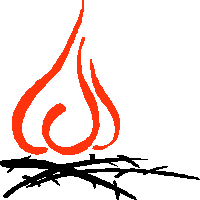


Hvaljen, moj Gospod,
v našem bratu ognju,
v katerem nam noč razsvetljuješ,
lep je in vesel in krepak in močan.
Sv. Frančišek Asiški
VUK ĆOSIĆ
A day in the life of a net.artist
Ever since the first contact between the protohominids and external reality, the activities of our species have been linked to usage of media, and in the same way the very first moment when the stick was used to hit someone or something, the connection between man and technology was established. Let's see what's new.
In the twentieth century, numerous artists and thinkers have addressed the issue of this particular relationship between a creative individual and the technology s/he uses to convey meaning. On the one hand, this dilemma has required a rethinking of the functioning of art itself, and on the other, a more profound understanding of the social, ideological and political influence of technology and media.
So today we say that art functions as a two point communication, facilitated by mediation. On one side we have the artist (as society labels creative individuals dedicated to the production of useless objects or processes), and on the other there's the non-artist, the person that is not responsible for the observed object or process. In an art system this non-artist is referred to as viewer, or reader, or moviegoer, etc. This scheme also works in reverse, and the output irresponsibly created by the non-artist is perceived by the creative individual - this perception is called art - and is eliminating the concept of art work. Well, this is basically how art per se looks today.
The question of technology seems more complex, just like nature for the eighteenth century philosophers, as Andreas Broeckmann said. Nevertheless, it can be said with a feeling of certainty that most technological innovations, at least in our soon-to- end-thanx-god century, are almost immediately embraced by creative artists, most probably because of inadequacies of the existing media in conveying meaning (oh, that expression again ), or, as Alexei Shoulgin once declared, because of a degenerated and repressive art system.
This finally brings us to media art, and more precisely to net.art, as the artistic expression within (or with the aid of) the Internet is referred to by most of the people involved.
The unique situation, dreamt by MarxBenjaminBeuys, where the artist owns the means of production/reproduction/distribution is finally at hand. Unlike the "camcorder revolution", which instead of democratising artistic production has only increased the profits of hardware makers + created a new elite of mediators, net.art includes remarkable distribution possibilities. The technology of existing computer networks is enabling the artist to approach (or at least address, we don't want to exaggerate) larger audiences than ever, and to approach them with the original ("aura's gone to heaven"), in a matter of miliseconds, over global distances, without the middleman. What is adding even more to it is the possibility of constantly updating or changing the creation offered. Art without the tangible work, art without constant and/or unique manifestation, that is the art that is being made by the net.artist.
This art form, which also happens to encompass text, graphics, audio and video is also technologically easier to master than most of the hi-tech "computer arts" (as if we had camera art, or brush art). In this detail lies the true advantage of net.art over most of the art forms of today. Thousands of people active in creating net. contents are imitating television, the film industry, and the gallery world, and these vulgarities are ubiquitous, but it is very comforting to declare that at the same time dozens of artists from various parts of the world are keeping their network of trust and their gift economy, thus showing another possible life for an artist. A technological restriction (in many ways similar to those imposed on poets by the sonnet or haiku) coming out of the necessary minimum for the maintenance of networks, is forcing net. artist to types of creativity that eliminate the already mentioned imitations. This is the reservoir from which new net.art is coming, or, as Pit Schultz once put it, "keep it in ascii sublime".
<Instead of a footnote, this is the place to add that the channel through which the "regular" artist places the <i>oeuvre</i> is not usually coupled with the back-channel, and the whole story of art as communication is now undergoing a critical reading.>
It is very important to observe how the net.artists are dealing with the problem/advantage of (non)signifying context.
As is commonly known, there are some strange people who create visual/performance/text art that doesn’t fit galleries/stages/books, and usually the art bureaucracy call these practices non-gallery pieces or paraliterary phenomena, or off-theatre. These practices are also commonly about the art system built around their respective expression decision, and very often the artists engaged in such practice make it their point not to be classifiable under known art history labels. The Internet seems to be offering a good environment for this kind of artist, and its lack of signifying signals (sorry, no "gallery" sign above an animated gif; no credible criticism under a piece of e-mail fiction; no anchor-man under a refresh loop) is of help with strategies like media hoax, culture jamming, and similar.
And now, after all of this, it is time to say the real title of this little text: it is "Responsibility of Art in the Age of Networked Digital Reproduction", but I didn't really want to make it visible.
Suggested readings/observations/views:
http://www.jodi.org/
Vuk Ćosić
ZKP vols. 1, 2, 3; ed. by Pit Schultz and Geert Lovink, Amsterdam, Madrid, Budapest, 1996
ZKP 3.2.1; ed. by V.C. Ljubljana, 1996
http://www.ljudmila.org/naps/
The Electronic Disturbance, by Critical Art Esemble, Autonomedia, 1994
http://www.ljudmila.org/fresh.htm
nettime-owner@is.in-berlin.de
Ta in vse naslednje strani so dostopne v dveh razlicicah:
Stran, ki jo gledate, je v 7 bitnem formatu, lahko pa jo zamenjate s
CP1250: ![]() .
.
Brat Ogenj na Internetu ureja Bostjan Vester:
![]() http://ana.fri.uni-lj.si/~bostjanv
http://ana.fri.uni-lj.si/~bostjanv
![]() bostjan.vester@snet.fri.uni-lj.si
bostjan.vester@snet.fri.uni-lj.si